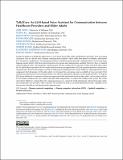| dc.contributor.author | Yang, Ziqi | |
| dc.contributor.author | Xu, Xuhai | |
| dc.contributor.author | Yao, Bingsheng | |
| dc.contributor.author | Rogers, Ethan | |
| dc.contributor.author | Zhang, Shao | |
| dc.contributor.author | Intille, Stephen | |
| dc.contributor.author | Shara, Nawar | |
| dc.contributor.author | Gao, Guodong Gordon | |
| dc.contributor.author | Wang, Dakuo | |
| dc.date.accessioned | 2024-06-06T19:05:17Z | |
| dc.date.available | 2024-06-06T19:05:17Z | |
| dc.date.issued | 2024-05-13 | |
| dc.identifier.issn | 2474-9567 | |
| dc.identifier.uri | https://hdl.handle.net/1721.1/155210 | |
| dc.description.abstract | Despite the plethora of telehealth applications to assist home-based older adults and healthcare providers, basic messaging and phone calls are still the most common communication methods, which suffer from limited availability, information loss, and process inefficiencies. One promising solution to facilitate patient-provider communication is to leverage large language models (LLMs) with their powerful natural conversation and summarization capability. However, there is a limited understanding of LLMs' role during the communication. We first conducted two interview studies with both older adults (N=10) and healthcare providers (N=9) to understand their needs and opportunities for LLMs in patient-provider asynchronous communication. Based on the insights, we built an LLM-powered communication system, Talk2Care, and designed interactive components for both groups: (1) For older adults, we leveraged the convenience and accessibility of voice assistants (VAs) and built an LLM-powered conversational interface for effective information collection. (2) For health providers, we built an LLM-based dashboard to summarize and present important health information based on older adults' conversations with the VA. We further conducted two user studies with older adults and providers to evaluate the usability of the system. The results showed that Talk2Care could facilitate the communication process, enrich the health information collected from older adults, and considerably save providers' efforts and time. We envision our work as an initial exploration of LLMs' capability in the intersection of healthcare and interpersonal communication. | en_US |
| dc.publisher | Association for Computing Machinery | en_US |
| dc.relation.isversionof | 10.1145/3659625 | en_US |
| dc.rights | Creative Commons Attribution | en_US |
| dc.rights.uri | https://creativecommons.org/licenses/by/4.0/ | en_US |
| dc.source | Association for Computing Machinery | en_US |
| dc.title | Talk2Care: An LLM-based Voice Assistant for Communication between Healthcare Providers and Older Adults | en_US |
| dc.type | Article | en_US |
| dc.identifier.citation | Yang, Ziqi, Xu, Xuhai, Yao, Bingsheng, Rogers, Ethan, Zhang, Shao et al. 2024. "Talk2Care: An LLM-based Voice Assistant for Communication between Healthcare Providers and Older Adults." Proceedings of the ACM on Interactive, Mobile, Wearable and Ubiquitous Technologies, 8 (2). | |
| dc.contributor.department | Massachusetts Institute of Technology. Department of Electrical Engineering and Computer Science | |
| dc.relation.journal | Proceedings of the ACM on Interactive, Mobile, Wearable and Ubiquitous Technologies | en_US |
| dc.identifier.mitlicense | PUBLISHER_CC | |
| dc.eprint.version | Final published version | en_US |
| dc.type.uri | http://purl.org/eprint/type/JournalArticle | en_US |
| eprint.status | http://purl.org/eprint/status/PeerReviewed | en_US |
| dc.date.updated | 2024-06-01T07:59:08Z | |
| dc.language.rfc3066 | en | |
| dc.rights.holder | The author(s) | |
| dspace.date.submission | 2024-06-01T07:59:09Z | |
| mit.journal.volume | 8 | en_US |
| mit.journal.issue | 2 | en_US |
| mit.license | PUBLISHER_CC | |
| mit.metadata.status | Authority Work and Publication Information Needed | en_US |
